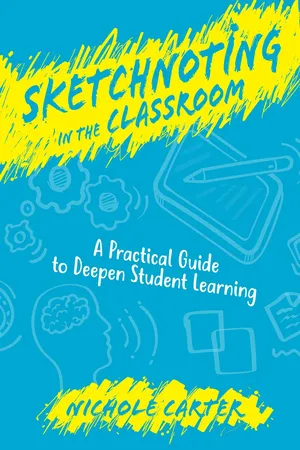
eBook - ePub
Sketchnoting in the Classroom
A Practical Guide to Deepen Student Learning
Nichole Carter
This is a test
- English
- ePUB (disponibile sull'app)
- Disponibile su iOS e Android
eBook - ePub
Sketchnoting in the Classroom
A Practical Guide to Deepen Student Learning
Nichole Carter
Dettagli del libro
Anteprima del libro
Indice dei contenuti
Citazioni
Informazioni sul libro
Author Nichole Carter shows how sketchnotes can help students retain new material, develop skills to articulate empathy and build connections to larger concepts. Sketchnoting in the Classroom includes strategies for helping students feel successful as they develop their skills, for example, asking them what their brain is telling them, asking how they learn best and encouraging the process through specific note-taking strategies.The book includes:
- Analysis of the brain science behind sketchnoting, including teaching students how to identify patterns and apply them effectively in their sketchnotes.
- Lesson ideas for sketchnoting across content areas, including science, social studies, English language arts and math.
- Tools and resources for both analog and digital sketchnoting techniques.
- Tips for using sketchnotes for professional development, including at conferences and at department or staff meetings.
- Examples from a variety of teachers with experience using sketchnotes in their classes.
This book makes sketchnotes more accessible to all teachers and helps both teachers and students feel confident in visual note-taking. Audience: 3-12 educators, teacher educators
Domande frequenti
Come faccio ad annullare l'abbonamento?
È semplicissimo: basta accedere alla sezione Account nelle Impostazioni e cliccare su "Annulla abbonamento". Dopo la cancellazione, l'abbonamento rimarrà attivo per il periodo rimanente già pagato. Per maggiori informazioni, clicca qui
È possibile scaricare libri? Se sì, come?
Al momento è possibile scaricare tramite l'app tutti i nostri libri ePub mobile-friendly. Anche la maggior parte dei nostri PDF è scaricabile e stiamo lavorando per rendere disponibile quanto prima il download di tutti gli altri file. Per maggiori informazioni, clicca qui
Che differenza c'è tra i piani?
Entrambi i piani ti danno accesso illimitato alla libreria e a tutte le funzionalità di Perlego. Le uniche differenze sono il prezzo e il periodo di abbonamento: con il piano annuale risparmierai circa il 30% rispetto a 12 rate con quello mensile.
Cos'è Perlego?
Perlego è un servizio di abbonamento a testi accademici, che ti permette di accedere a un'intera libreria online a un prezzo inferiore rispetto a quello che pagheresti per acquistare un singolo libro al mese. Con oltre 1 milione di testi suddivisi in più di 1.000 categorie, troverai sicuramente ciò che fa per te! Per maggiori informazioni, clicca qui.
Perlego supporta la sintesi vocale?
Cerca l'icona Sintesi vocale nel prossimo libro che leggerai per verificare se è possibile riprodurre l'audio. Questo strumento permette di leggere il testo a voce alta, evidenziandolo man mano che la lettura procede. Puoi aumentare o diminuire la velocità della sintesi vocale, oppure sospendere la riproduzione. Per maggiori informazioni, clicca qui.
Sketchnoting in the Classroom è disponibile online in formato PDF/ePub?
Sì, puoi accedere a Sketchnoting in the Classroom di Nichole Carter in formato PDF e/o ePub, così come ad altri libri molto apprezzati nelle sezioni relative a Didattica e Tecnologia nella didattica. Scopri oltre 1 milione di libri disponibili nel nostro catalogo.
Informazioni
Argomento
DidatticaCategoria
Tecnologia nella didatticaSECTION I
THE WHAT & WHY OF SKETCHNOTES
CHAPTER 1 Sketchnote Beginnings
CHAPTER 2 The Brain Research Behind Sketchnotes
CHAPTER 3 Standards, Metacognition & Focus
CHAPTER 4 Introducing Sketchnotes in a Class
CHAPTER 5 Analog versus Digital
CHAPTER 6 Real-Time versus Revisited Strategies
CHAPTER 1
SKETCHNOTE BEGINNINGS

Sketchnotes are a form of note taking. What is special about sketchnoting is that it teaches the best forms of strategic note taking, listening comprehension, synthesis, Dual Coding Theory, and note hierarchy. Plus, it allows note takers to personalize the experience based on their own past knowledge and, to some extent, their emotional connection to the new information they are learning.
The History of Modern Sketchnotes
Although the story of modern sketchnotes and graphic recording can be traced back at least fifty years ago, in reality people have been telling stories and making connections with images since the cave drawings of Sulawesi, Indonesia, over 35,400 years ago. Despite this common ancestry, sketchnotes and graphic recording have definite differences.
Sketchnotes and visual note taking are similar in definition, and educators have been using visuals for decades, especially in relation to language acquisition. The word sketchnotes can be traced back to Mike Rohde and 2007; since then, the practice of sketchnoting, whether in a digital or analog form, has taken off. Sketchnotes for professional development and their use in education can be traced back to 2013, when Sylvia Duckworth, an educator from Toronto, began sketchnoting edtech buzzwords and pedagogy.

Graphic recording, however, can be traced back to the 1970s when visual facilitation experts could be seen popping up in board meetings. We are currently in the fifth or sixth wave of graphic recording. Today, for example, Fortune 500 companies ask graphic recording artists to record and make sense of their planning meetings. Graphic recording is much more difficult than sketchnoting, as it requires not just listening comprehension but the ability to make your notes consumable for others. With sketchnotes, the audience is you; it is a form of note taking that sticks, because it is unique and personal to you. For instance, this is how I would draw a sketchnote on what I learned about the differences between sketchnotes and graphic recording.
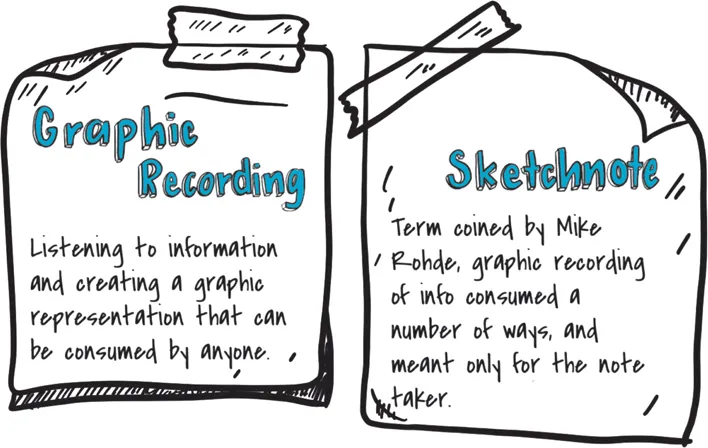
Yes, You Can Draw!
If you are looking at some of my sketchnotes already and comparing your first attempts, please don’t. Sketchnoting takes practice, and that is what this book is all about. One of the things that I hear the most from adults, and students over the age of twelve, is that they can’t draw.
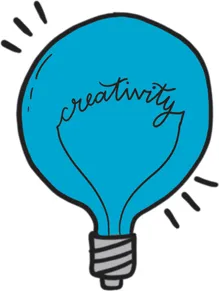
By the time we reach middle school, many of us have identified ourselves as artistic or just not. In this book, we are going to let go of those preconceived notions and judgments. Moving forward you are a sketchnoter. You are taking the first steps to have the skill set to make this easier and easier for your brain and your artistic abilities!

Scan the QR code for Graham Shaw’s TEDx Talk, “Why People Believe They Can’t Draw.” Get out a pen and paper or a digital device, and draw along with him.
You can’t pick up a pencil and expect to draw the Mona Lisa on the first go; you have to practice. As my friend and colleague Carrie Baughcum (@HeckAwesome), a fellow sketchnoter, likes to say, “It’s not a sprint, it’s a marathon.” She’s right: You get better and better the more you train. The more you ask your brain to conjure up images or symbols, the easier it becomes. To prove it, jump-start your brain with a little game.

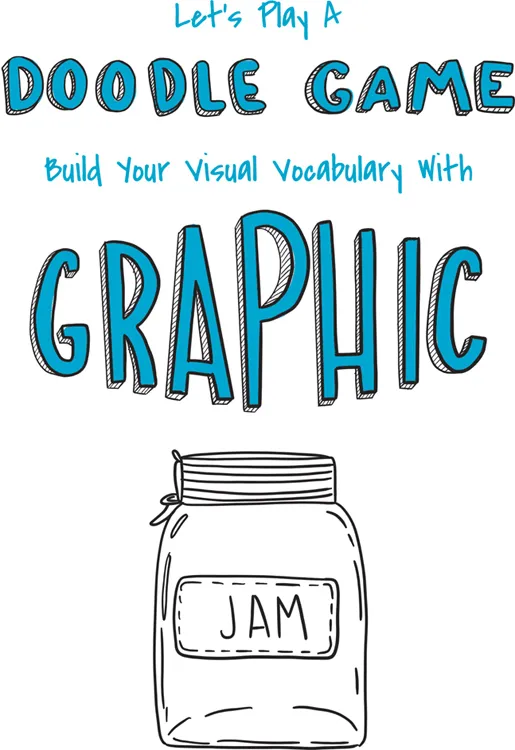
Draw an icon or image for each of the words in the bottom-left corner. Time yourself, allowing about 10 seconds to just draw, before moving to the next word.

What is interesting about this activity (which was inspired by a similar one in Sunni Brown’s The Doodle Revolution) is that our brains can come up with different icons and images for the same word. This makes our notes unique to us, thus helping with the retention. For example, when I introduce sketchnoting to a class—of educators or students—I always ask them to draw the word cup. Some will draw a water cup, and some will draw a coffee or tea cup. When I ask people how they might draw a phone, students automatically think of the iconic iPhone, which is much easier to draw. Adults typically think of a rotary phone and attempt to draw that, which is obviously much more difficult. Sometimes age and life experiences can influence your thought process.

In the space provided draw a cup and a phone.

This difference of perspective is again what makes sketchnotes so important: They are unique to you. Giving your brain freedom of expression in that manner is a skill to practice. Try it now: Draw a symbol or icon for the word life.
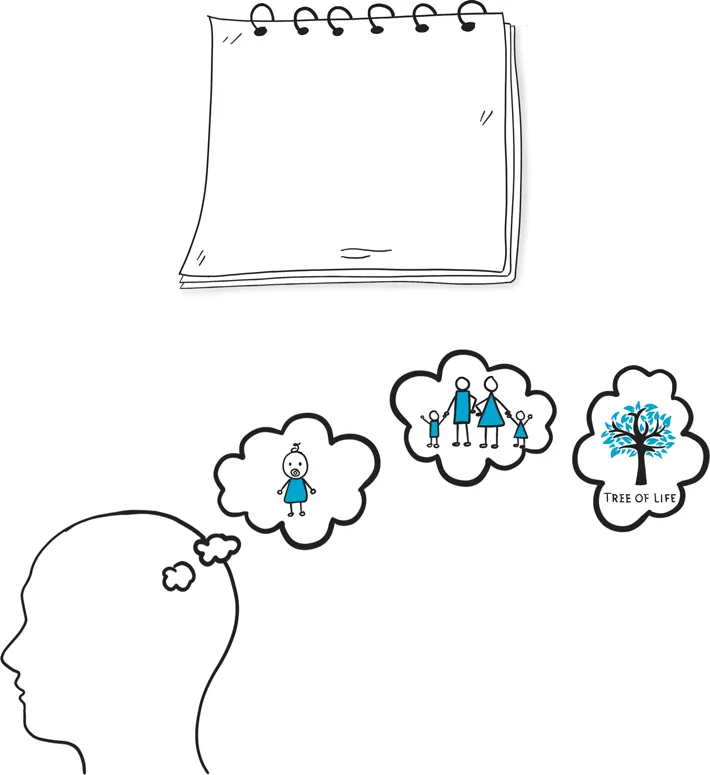
A great way to continue your practice, or provide some for your students, is to check out the book’s companion site for Chapter 1 to find a list of school-related icons to draw.
Another option is to try Google Quick, Draw! With this online game, you draw the suggested word, while Google AI tries to guess what you are drawing! To try Google Quick, Draw!, scan the QR code.


CHAPTER 2
THE BRAIN RESEARCH BEHIND SKETCHNOTES
Brains love the ability to practice and build their muscle memory. We call this building

Brains also love visuals, and they need connections for what they learn. The more connections, the deeper the learning.

If we deliver information in only one specific way, we are neglecting other brain functions. When we teach the skill of reading, we know that in order for the brain to comprehend the text many different connections and areas of the brain have to be functioning. Sketchnotes ...
Indice dei contenuti
- COVER
- TITLE PAGE
- DEDICATION
- COPYRIGHT
- ABOUT ISTE
- ABOUT THE AUTHOR
- ACKNOWLEDGMENTS
- CONTENTS
- WHO IS THIS BOOK FOR?
- SECTION I: THE WHAT & WHY OF SKETCHNOTES
- SECTION II: SKETCHNOTES ACROSS CONTENT AREAS
- JOIN AN ONLINE COMMUNITY
- REFERENCES
- INDEX
- BONUS MATERIAL
- BACK COVER
Stili delle citazioni per Sketchnoting in the Classroom
APA 6 Citation
Carter, N. (2019). Sketchnoting in the Classroom ([edition unavailable]). International Society for Technology in Education. Retrieved from https://www.perlego.com/book/979229/sketchnoting-in-the-classroom-a-practical-guide-to-deepen-student-learning-pdf (Original work published 2019)
Chicago Citation
Carter, Nichole. (2019) 2019. Sketchnoting in the Classroom. [Edition unavailable]. International Society for Technology in Education. https://www.perlego.com/book/979229/sketchnoting-in-the-classroom-a-practical-guide-to-deepen-student-learning-pdf.
Harvard Citation
Carter, N. (2019) Sketchnoting in the Classroom. [edition unavailable]. International Society for Technology in Education. Available at: https://www.perlego.com/book/979229/sketchnoting-in-the-classroom-a-practical-guide-to-deepen-student-learning-pdf (Accessed: 14 October 2022).
MLA 7 Citation
Carter, Nichole. Sketchnoting in the Classroom. [edition unavailable]. International Society for Technology in Education, 2019. Web. 14 Oct. 2022.